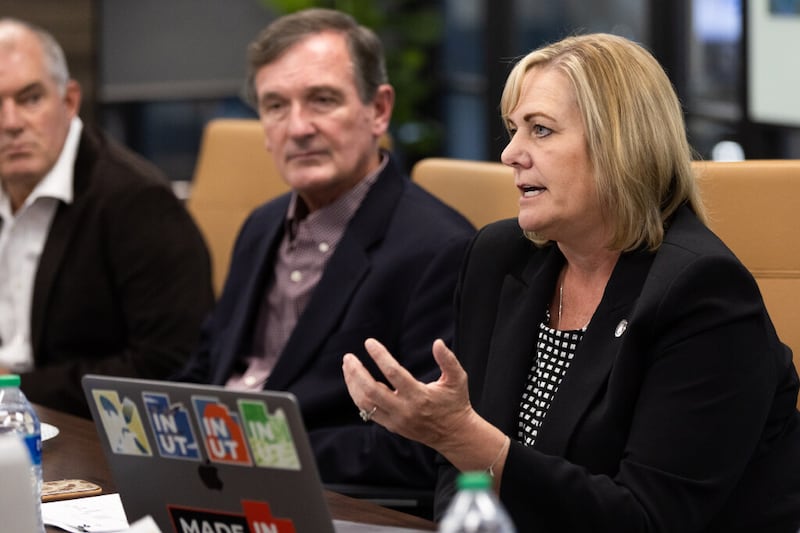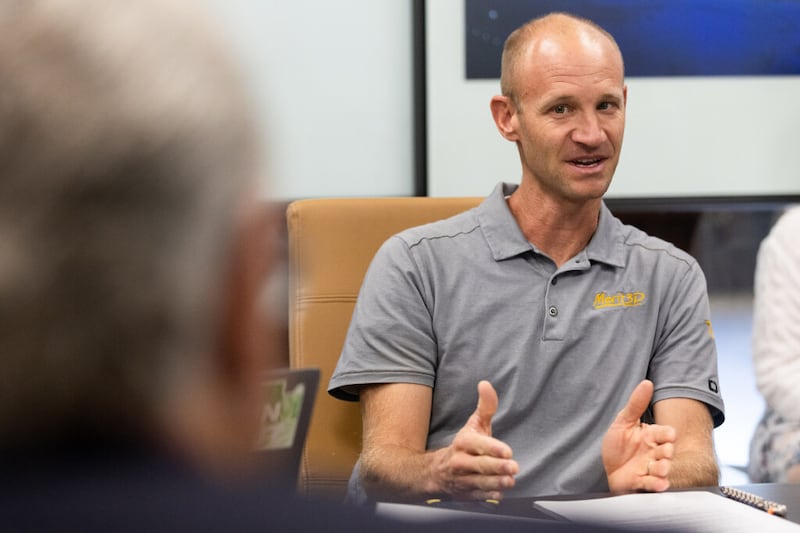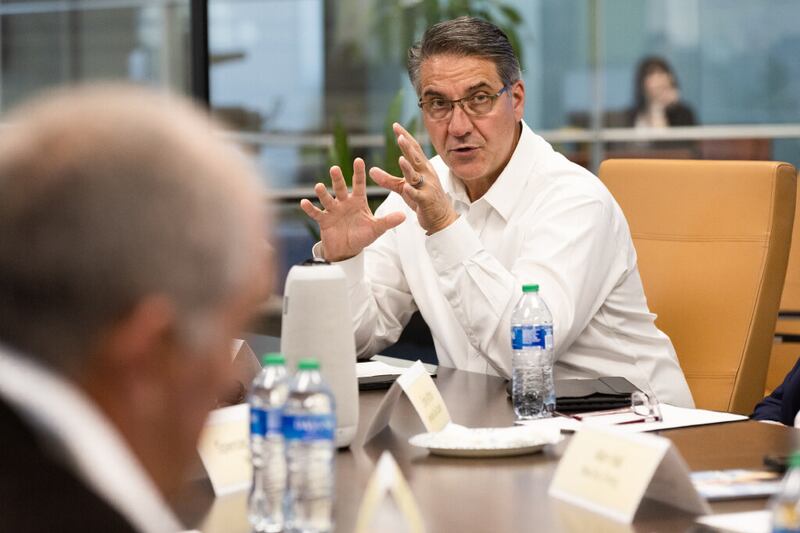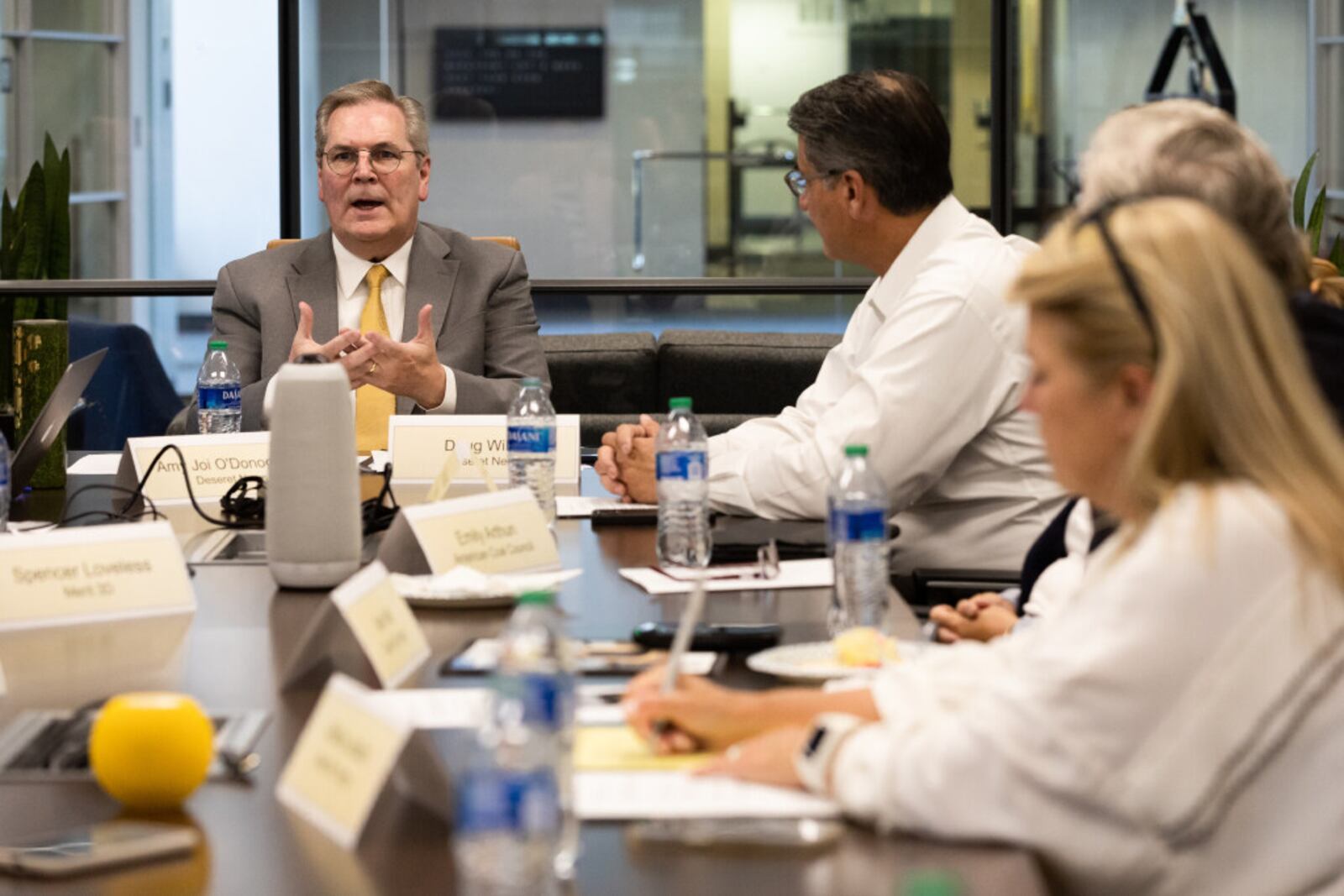Doug Wilks, Deseret News executive editor, moderates a roundtable discussion on coal mining and manufacturing in the Deseret News conference room in Salt Lake City. | Photo by Megan Nielsen, Deseret News
Last month, Utah Business partnered with Deseret News to host a roundtable on the future of the coal industry with leaders in the space. Moderated by Doug Wilks, executive editor of Deseret News, they discussed the war on coal, capital, manufacturing and more. Here are a few highlights from the conversation.
What is the current landscape of the coal industry?
Mike Kourianos | Mayor | Price City
After the closure of one coal-fired power plant in Carbon County, we lost our tax revenue and mineral money. We used to thrive on that revenue, but now the mineral is in Emery County and Sanpete County. The portals might be in Carbon County, but the mineral itself is in those other two counties, so they’re getting those revenues. Our community feels that loss. Our commissioners have had to raise the taxes on our citizens by 700 percent. Those commissioners went through a lot of turmoil, but it was something that had to be done because mining is not prevalent.
Emily Arthun | CEO | American Coal Council
Since our president said he wants to end coal—coal miners, jobs, energy—there are policymakers that do not like coal, and they’re trying everything they can to end the use of coal. We need to save coal because the United States is on a trajectory of energy poverty. We have enjoyed economic growth because of our fossil fuels, particularly coal, and what coal brings us—which is not only energy. We’re on a timeline that is unachievable for green energy. We do not have enough critical minerals mined today in the world, let alone in the United States. We’re not only fighting fossil fuels; we’re fighting our lifestyle and the way we conduct business.
Alan Hall | CEO | Blue Sky Energy
We’re evolving coal. Our belief is that mother coal is good, and it’s been condemned for a number of reasons that we understand, but coal is so full of other components that we need every day. We’ll transition over eventually to cleaner types of coal, but we’re going to need to use some coal/carbon products every day. If we don’t, we’re in trouble as a country in order to just meet basic needs.
Eric Hall | VP, Sales | Blue Sky Energy
This is not your grandfather’s coal. We are re-imagining coal. We are reinventing what coal can do beyond just burning and supplying power. Coal touches every part of our lives: the bottles we drink from, the cars we drive, the roads we drive on. Coal is everywhere.
Spencer Loveless | Founder, CEO | Merit3D
We need to transition and evolve. We’re going to push this as hard as we can to make it go through, but what’s the backup plan? How do we transition southeast Utah to a tech manufacturing economy and challenge the supply chains we’re currently dependent on? We are focused on advanced manufacturing, additive manufacturing, 3D printing and evolving as these challenges come up.
Kori Ann Edwards | Managing Director | Utah Governor’s Office of Economic Opportunity
We need to fight for coal. There’s a whole evolution going on around just our critical minerals and our core minerals. Utah has 42 of the 51 critical minerals the world needs. We are partnering with Nevada, Idaho and Colorado because we’re such critical and rich mineral states. We also need to look at what we can do to diversify our counties and bring in new industries. It is important to look at the situation from several different sectors to make sure those communities are thriving and preparing for the future.
What is the role of capital in the coal industry?
Lyle Pearson | Managing Director | Rainstar Capital Group
I’m very passionate about this and the capital we have for this project in the long term. We’re looking roughly at a five-year performer, worst case, and providing the capital so you essentially can grow and meet the needs and expectations of what Alan’s put together. The problem is becoming the opportunity.

Kori Ann Edwards | Photo by Megan Nielsen, Deseret News
Where’s the disconnect between mining and manufacturing?
Emily Arthun | CEO | American Coal Council
When you talk to industry professionals, there is a large percentage saying, “I don’t want my children going into this as a career,” so the people they talk to don’t choose this as an occupation. If these mines came online today, we do not have enough skilled labor in the pipeline to actually produce. We have to be proud of this industry. We cannot sit around and not engage and keep our opinions to ourselves.
Today, there is a different narrative happening, and our industry is starting to recognize it is time to engage. The U.S. cannot forget that coal is abundant, accessible, affordable and a base load power. We have to have clean power. We have to invest in technology. We have to be innovative. Without our base load power and supporting these power plants in Utah and giving them the ability to add the necessary things to become clean, the U.S. will have an economic shortfall.
Spencer Loveless | Founder, CEO | Merit3D
Training in the trades is key, and it’s key to what we’re doing as well. We’ve taken and taught coal miners computer-aided design—we call it coal to CAD—and now they’re doing 3D design. We benefit from giving them the opportunity to get into a career and teach them a brand new skill.
Craig Eatough | President | Combustion Resources
A lot of people will think 3D printing is totally different than coal, but we’re putting it forward as a part of coal’s evolution. When we convert coal and refine it into its individual components, some of those chemicals are extremely valuable, much more valuable than coal as it’s sold from the mine. One of the key materials that would come out of coal is plastics. Plastics and other materials can be and are currently being derived from either petroleum or coal. These feedstocks come out of coal and drive other manufacturing processes.
Mickey Jacobs | Contributor | Utah Business
I wrote an article for the May issue of Utah Business about the lack of skilled workers in the trades. One of the things I found so interesting is everything the skilled trades groups are doing at the high school level. Construction, plumbing—everybody is working together to teach and support kids at the high school level. When they leave high school, they’re leaving with a great education, paid on-the-job training and a full-time job. We need more of this.
Kori Ann Edwards | Managing Director | Utah Governor’s Office of Economic Opportunity
Manufacturing is one of our top GDP industries because we have cost-effective power. That’s going to be affected. Additionally, we’ve got this big push toward electric vehicles, which is all going to require us to plug in, so we are looking at increased power needs there. If their cost keeps coming up, the balance sheets are not aligning.
Can Blue Sky find the talent needed to achieve its planned growth? Where is the skillset coming from?
Jeff Lowe | President, Engineering | Blue Sky Energy
We’re seeing that people want to come our way because we’re above ground. It’s all being above ground versus below ground. We’ve had great success, and the mayor has helped us out a bunch in that area.
We’ve also raised our wages, which helps a lot.
Alan Hall | CEO | Blue Sky Energy
I’ve had disagreements with how some are moving forward to address industry needs. There’s some resistance. We need to be training students on the really cool things that pertain to mining, coal and new products and bringing the next population of students aboard. We need to go to universities and say, “This is what we need.”

Spencer Loveless | Photo by Megan Nielsen, Deseret News
Is there a market for what Blue Sky Energy is trying to do? Is the technology there to make it scalable and worthwhile?
Alan Hall | CEO | Blue Sky Energy
Yes. The number one product we’ll sell will be activated carbon—a huge market coming out of coal.
There’s also an opportunity that the University of Wyoming is working on with putting activated carbon back into the ground as part of a fertilizer amending the soil. Those two alone have enormous markets.
Craig Eatough | President | Combustion Resources
It’s already being used in a lot of areas. Nothing we’re incorporating is actually new technology. Gas separations are common. We just need to apply it to our gas to pull the hydrogen away from the methane, carbon monoxide and those gases.
Jeff Lowe | President, Engineering | Blue Sky Energy
We have a small development system in Salt Lake City, a massive development system in Wellington and Price, and a pretty aggressive plan to have four more units running in 2024. The next system is going to have wider ranges from a product standpoint. Right now, we produce oil and char and gas, but to go into the products that Alan’s talking about, there are some more add-ons that we’re going to be doing on those.
Kori Ann Edwards | Managing Director | Utah Governor’s Office of Economic Opportunity
Blue Sky Energy is doing great things, and we’ve been working on this with Carbon and Emery County for a while, too. Coal can be burned down to coal pitch, which is used to make carbon fiber. Any time you want to lighten something, carbon fiber is one of the necessary materials. We currently have an EDA power grant for this area, working with the University of Utah, to start testing the fibers taken from coal pitch.
What does the future of mining look like?
Emily Arthun | CEO | American Coal Council
Mining is already there. There are autonomous vehicles underground that have been there for a long time. There are surface mines that are running driverless trucks. Mining is evolving, and it is already using new technology. Mining is a very safe profession, and it has gotten there because of disasters. Mining is heavily regulated—more so than any other industry. There is a future in mining, and it will be technological, and it will appeal to kids, and they’ll be able to run a dragline from an office with their remotes at some points.
Jeff Lowe | President, Engineering | Blue Sky Energy
The world and the media and everybody looks at coal as bad, but if you start dropping down to the second and the third and the fourth level of how it affects all of our lives and standard of living, it’s just enormous. People don’t understand that everything around this table—almost every one of these pieces of products—comes from coal. It is a PR thing that we need to get down.
Why are you passionate about this work? Why continue to do it?
Craig Eatough | President | Combustion Resources
The one thing I really want is clean water, clean air and a beautiful planet to live on. People, in general, don’t have the vision of how to get there. We look at increasing efficiency so we use less energy. We look at making things lighter, stronger and faster. Where do we get the materials to make this happen? Coal. Trying to get that message out and developing the technologies to make it happen gets me out of bed in the morning.
Lyle Pearson | Managing Director | Rainstar Capital Group
We have a natural resource in this state alone that brings a cost-effective solution for energy.
This brings opportunities back to the younger generation to build a future, an income and happiness for themselves and their families.
Eric Hall | VP, Sales | Blue Sky Energy
The general community public has no idea how far-reaching fossil fuels and coal are. There is an ignorant and narrow-sighted view of just how important these materials are. Everyone sees coal as a burning product—that’s it. But if you explore the possibilities of coal, everything you touch has coal within it. If the general public knew that, it would change their minds.
Mike Kourianos | Mayor | Price City
My passion is to make sure our communities, Carbon and Emery County, are sustainable. I think this movement was started because they thought we weren’t good stewards of our environment, but I think with this new technology and direction, we are going to be even better stewards of our environment. It’s going to make us sustainable.
Spencer Loveless | Founder, CEO | Merit3D
I was born and raised in Carbon County. I love it. Part of the opportunity we have with additive manufacturing is to change people, to change an economy, to change supply chains. We had a vacuum that was a $400 vacuum during COVID-19. But because we had a $4 part stuck on the ocean, we couldn’t sell it. So we 3D printed the part to solve our problem. Now, you can 3D print parts that affect national security. That is why I am passionate about this.

Mike Kourianos | Photo by Megan Nielsen, Deseret News


